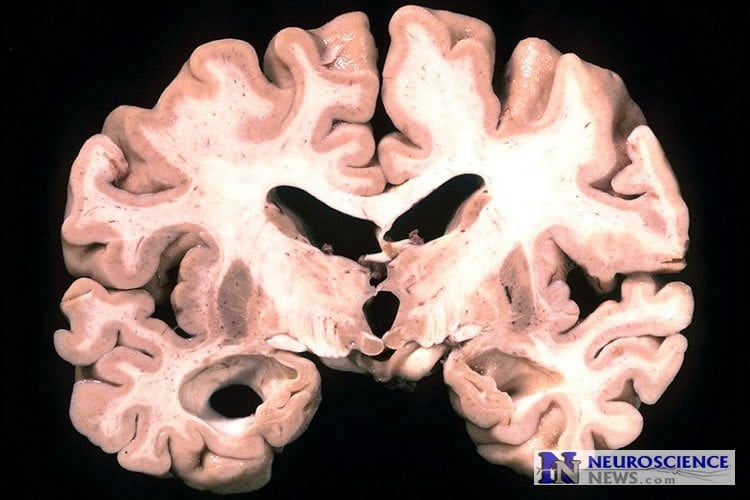Summary: Researchers believe their new findings may supersede the amyloid hypothesis of Alzheimer’s disease.
Source: RUB.
The following factors facilitate the formation of putatively toxic structures in the neuronal nuclei of Alzheimer’s patients.
Spherical structures in the nucleus of nerve cells, so-called nuclear spheres, are suspected to trigger Alzheimer’s disease. A team headed by Dr Thorsten Müller from the research group Cell Signaling in Neurodegeneration has for the very first time demonstrated the presence of the presumably toxic protein aggregates in the human brain. The researchers from Ruhr-Universität Bochum have published their article in the journal Neurobiology of Aging.
Number of nuclear spheres higher in Alzheimer’s patients
The team compared brain samples from Alzheimer’s patients with those of the healthy individuals in the same age group. The result: in the samples taken from Alzheimer’s patients, the number of nuclear spheres was much higher than in those taken from healthy study participants.
Moreover, the group from Bochum analysed in what way nuclear spheres are generated. It was demonstrated in experiments with cell cultures that the amyloid precursor protein (APP) plays a crucial role in this process. APP has long been associated with Alzheimer’s disease. The researchers observed that nuclear sphere generation preferably takes place, if the amyloid precursor protein carries no phosphate group in a specific amino acid. An APP cleavage product, moreover, is contained in the nuclear spheres.
Crucial mechanism of Alzheimer’s disease
The researchers have ascertained that decreased phosphorylation mainly occurs in those areas of the brain that have a high plaque load, typical of Alzheimer’s disease. The researchers have published an article on this topic in the journal “Cellular Signalling” in August 2016.

“We assume that nuclear spheres are toxic and contribute to the death of nerve cells,” explain Katharina Kolbe and Hassan Bukhari, lead authors of the publications. The generation of nuclear spheres may thus be a crucial mechanism for Alzheimer’s disease.
New findings might supersede the amyloid hypothesis
“In the medium term, the results we have gained will pave the way for novel Alzheimer’s hypotheses that go beyond the amyloid hypothesis, which has been studied for over 20 years,” says Thorsten Müller. One should not rule out the possibility that these findings may gain crucial importance in therapeutic interventions in the long term.
Funding: The research was funded by the German Research Foundation (MU3525/3), as well as by the Mercator Research Center Ruhr (MERCUR: AN-2013-0024) and Forschungsförderung Ruhr-Universität Bochum Medizinische Fakultät (F800-2014).
Source: RUB
Image Source: NeuroscienceNews.com image is in the public domain.
Original Research: Abstract for “Extensive nuclear sphere generation in the human Alzheimer’s brain” by Katharina Kolbe, Hassan Bukhari, Christina Loosse, Gregor Leonhardt, Annika Glotzbach, Magdalena Pawlas, Katharina Hess, Carsten Theiss, and Thorsten Müller in Neurobiology of Aging. Published online August 18 2016 doi:10.1016/j.neurobiolaging.2016.08.016
[cbtabs][cbtab title=”MLA”]RUB “Poison in the Brain: Toxic Structures in Neuronal Nuclei of Alzheimer’s Patients.” NeuroscienceNews. NeuroscienceNews, 14 September 2016.
<https://neurosciencenews.com/alzheimers-toxicity-neuronal-nuclei-5063/>.[/cbtab][cbtab title=”APA”]RUB (2016, September 14). Poison in the Brain: Toxic Structures in Neuronal Nuclei of Alzheimer’s Patients. NeuroscienceNew. Retrieved September 14, 2016 from https://neurosciencenews.com/alzheimers-toxicity-neuronal-nuclei-5063/[/cbtab][cbtab title=”Chicago”]RUB “Poison in the Brain: Toxic Structures in Neuronal Nuclei of Alzheimer’s Patients.” https://neurosciencenews.com/alzheimers-toxicity-neuronal-nuclei-5063/ (accessed September 14, 2016).[/cbtab][/cbtabs]
Abstract
Extensive nuclear sphere generation in the human Alzheimer’s brain
Background
Nuclear spheres are protein aggregates consisting of FE65, TIP60, BLM and other yet unknown proteins. Generation of these structures in the cellular nucleus is putatively modulated by the amyloid precursor protein (APP), either by its cleavage or its phosphorylation. Nuclear spheres were preferentially studied in cell culture models and their existence in the human brain had not been known.
Method
Existence of nuclear spheres in the human brain was studied using immunohistochemistry. Cell culture experiments were used to study regulative mechanisms of nuclear sphere generation.
Results
The comparison of human frontal cortex brain samples from Alzheimer’s disease (AD) patients to age-matched controls revealed a dramatically and highly significant enrichment of nuclear spheres in the AD brain. Co-staining demonstrated that neurons are distinctly affected by nuclear spheres, but astrocytes never are. Nuclear spheres were predominantly found in neurons that were negative for APP T668 phosphorylation. Cell culture experiments revealed that JNK3-mediated APP phosphorylation reduces the amount of sphere-positive cells.
Conclusion
The study suggests that nuclear spheres are a new APP-derived central hallmark of AD, which might be of crucial relevance for the molecular mechanisms in neurodegeneration.
“Extensive nuclear sphere generation in the human Alzheimer’s brain” by Katharina Kolbe, Hassan Bukhari, Christina Loosse, Gregor Leonhardt, Annika Glotzbach, Magdalena Pawlas, Katharina Hess, Carsten Theiss, and Thorsten Müller in Neurobiology of Aging. Published online August 18 2016 doi:10.1016/j.neurobiolaging.2016.08.016






